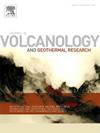In one step: Insights into shallow differentiation from basalt to rhyolite at Cordón Caulle from rhyolite-MELTS simulations
IF 2.3
3区 地球科学
Q2 GEOSCIENCES, MULTIDISCIPLINARY
Journal of Volcanology and Geothermal Research
Pub Date : 2025-03-03
DOI:10.1016/j.jvolgeores.2025.108305
引用次数: 0
Abstract
Magma mush systems are commonly invoked as the source from which crystal-melt segregation produces rhyolites, but these systems are rarely observed. The 2011–2012 VEI 4 eruption of Cordón Caulle produced rhyolite lavas which scavenged basaltic enclaves. These enclaves contain interstitial glass similar to their host rhyolitic lava, suggesting that these enclaves offer a window into an active, shallow basaltic mush system. This mush was proposed as the source from which crystallization generates high-silica rhyolite in a single step. Here, we use rhyolite-MELTS to determine whether this is thermodynamically realistic. First, we use melt geobarometry to establish that enclave-derived pressures (∼25–200 MPa) are consistent with those previously determined for the lavas. We then simulate isobaric crystallization using a range of initial starting water concentrations to test if it is possible to generate rhyolites of the appropriate composition, assuming a starting composition which is the same as the basaltic enclave whole-rock. We find that it is possible to produce suitable rhyolitic compositions via fractional crystallization. We then explore the simulated physical consequences of crystallization and fluid exsolution. Lower water simulations (0.5–1.0 wt.% H2O) at pressures of 100–200 MPa produce changes in volume most consistent with pre-eruptive ground deformation signals. We determine the timescales of heat loss from the crystallizing basaltic magma to be ∼8–25 ka, but it is plausible that heat loss occurred on the order of ∼1–10 ka which is broadly consistent with repose times of the system. The application of rhyolite-MELTS to an actively monitored system offers multifaceted insights into the geochemical, thermal, and physical evolution of magmas.
一步:从流纹岩- melt模拟中了解Cordón Caulle从玄武岩到流纹岩的浅层分异
岩浆浆液系统通常被认为是结晶-熔体分离产生流纹岩的来源,但这些系统很少被观察到。2011-2012年,Cordón Caulle火山VEI 4喷发产生流纹岩熔岩,清除了玄武岩飞地。这些包裹体含有与其寄主流纹岩熔岩相似的间隙玻璃,表明这些包裹体为研究活跃的浅玄武岩泥状体系提供了一个窗口。该浆料被认为是结晶过程中一步生成高硅流纹岩的来源。在这里,我们使用流纹岩熔体来确定这在热力学上是否真实。首先,我们使用熔体地球气压测定法来确定飞地衍生的压力(~ 25-200 MPa)与先前确定的熔岩压力一致。然后,我们使用一系列初始起始水浓度来模拟等压结晶,以测试是否有可能产生适当成分的流纹岩,假设起始成分与玄武岩包裹体全岩相同。我们发现通过分馏结晶可以得到合适的流纹岩成分。然后我们探讨了结晶和流体析出的模拟物理后果。在100-200兆帕压力下,较低的水模拟(0.5-1.0 wt.% H2O)产生的体积变化与爆发前的地面变形信号最一致。我们确定结晶玄武岩岩浆热损失的时间尺度为~ 8-25 ka,但热损失发生在~ 1-10 ka量级是合理的,这与系统的休息时间大致一致。流纹岩-熔融体应用于主动监测系统,可以从多方面了解岩浆的地球化学、热学和物理演化。
本文章由计算机程序翻译,如有差异,请以英文原文为准。
求助全文
约1分钟内获得全文
求助全文
来源期刊
CiteScore
5.90
自引率
13.80%
发文量
183
审稿时长
19.7 weeks
期刊介绍:
An international research journal with focus on volcanic and geothermal processes and their impact on the environment and society.
Submission of papers covering the following aspects of volcanology and geothermal research are encouraged:
(1) Geological aspects of volcanic systems: volcano stratigraphy, structure and tectonic influence; eruptive history; evolution of volcanic landforms; eruption style and progress; dispersal patterns of lava and ash; analysis of real-time eruption observations.
(2) Geochemical and petrological aspects of volcanic rocks: magma genesis and evolution; crystallization; volatile compositions, solubility, and degassing; volcanic petrography and textural analysis.
(3) Hydrology, geochemistry and measurement of volcanic and hydrothermal fluids: volcanic gas emissions; fumaroles and springs; crater lakes; hydrothermal mineralization.
(4) Geophysical aspects of volcanic systems: physical properties of volcanic rocks and magmas; heat flow studies; volcano seismology, geodesy and remote sensing.
(5) Computational modeling and experimental simulation of magmatic and hydrothermal processes: eruption dynamics; magma transport and storage; plume dynamics and ash dispersal; lava flow dynamics; hydrothermal fluid flow; thermodynamics of aqueous fluids and melts.
(6) Volcano hazard and risk research: hazard zonation methodology, development of forecasting tools; assessment techniques for vulnerability and impact.

 求助内容:
求助内容: 应助结果提醒方式:
应助结果提醒方式:


